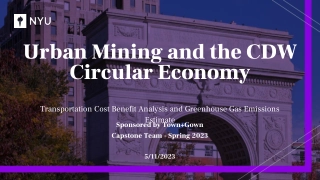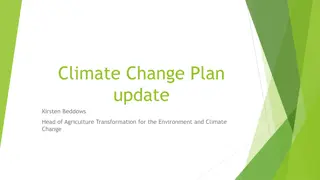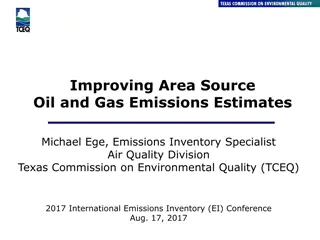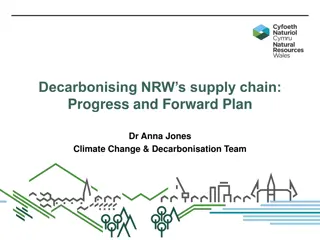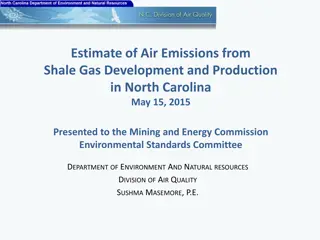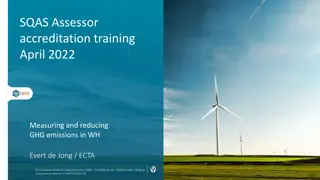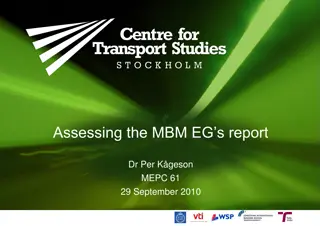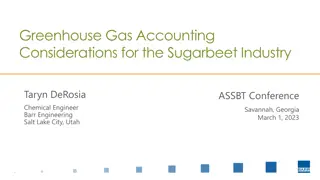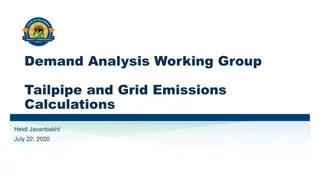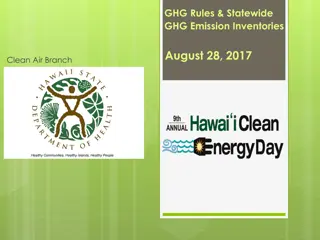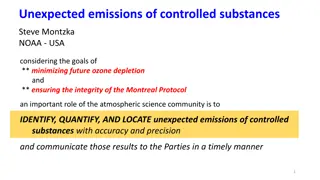Potential Reduction of GHG Emissions by Working at Home
This analysis explores the impact of increased remote work on reducing greenhouse gas emissions, particularly in the context of the COVID-19 lockdown. By examining workforce data, commuting patterns, and emission statistics in California, the study aims to quantify the potential decrease in GHG emissions from feasible increases in working from home. The findings highlight the significant role remote work can play in reducing emissions from motor vehicles, shedding light on the environmental benefits of a shift towards remote work policies.
Download Presentation

Please find below an Image/Link to download the presentation.
The content on the website is provided AS IS for your information and personal use only. It may not be sold, licensed, or shared on other websites without obtaining consent from the author. Download presentation by click this link. If you encounter any issues during the download, it is possible that the publisher has removed the file from their server.
E N D
Presentation Transcript
How Much Can Working at Home Reduce GHG Emissions? Ysbrand van der Werf, Ph.D. 22 July 2020
Introduction During the COVID-19 lockdown many people have been working at home with more success than had been thought possible. Gasoline sales plummeted and consequently emissions from motor vehicles have also plummeted. This leads one to ask: how much can increased work at home reduce GHG emissions? The analysis presented here is an attempt to quantify the reduction in GHG emissions from feasible increases in working at home 2
Data and Organization Three types of data 1. Workforce: US census 2. Commuting: US census and CSTDM 3. Emissions: EMFAC They are used to show us A. the pre-COVID reduction in GHG emissions from working at home B. three scenarios of possible GHG reductions that would result from an increase in working at home 3
California Workforce Data Using county-level census data for 2018, which is the most recent available From the American Community Survey This data includes exactly 30 counties that include over 96% of workforce. 4
California Commuter Data The American Community Survey provides data on commute mode by sector for each county 13 sectors and 5 modes. The modes are: 1. Drive alone 75 percent 2. Carpool or vanpool 10 percent 3. Public Transit 5 percent 4. Miscellaneous 5 percent 5. Work at Home 5 percent Of these, we assume that only those who drive alone can reduce GHG emissions 5
California Commuter Data, pt. 2 Two sectors are used for this analysis: 1. Information and finance and insurance, and real estate and rental and leasing 2. Professional, scientific, and management, and administrative and waste management services Combined, these account for: A. 22 percent of California s workforce B. 41 percent of California s work-at-home force 6
California Commuter Data, pt. 3 ACS provides data for commute time in each county, but not for commute distance Data for commute distance in each county for 2015 is from CSTDM data for the California Transportation Plan 2040 This 2015 commute distance correlates well with 2018 commute time (it actually correlates better than 2015 commute time). I assume that this is the same for all sectors 7
California Emissions Data Emission data by vehicle class are from EMFAC estimates for 2018 by CARB EMFAC emissions per mile and trip are both used Vehicle population by class are taken from DMV data prepared by Energy Commission staff and are mapped to the EMFAC classes 97% of vehicles are fueled by gasoline, but all are assumed to be gasoline fueled for this study 8
In Summation Data analyzed is for Gasoline 97% Thirty counties 96% Single drivers only 75% Two economic sectors 22% Of the 17,418,097 commuters in California, we look at 2,770,659 commuters who can reduce their GHG emissions by working at home. 9
How Much Are GHG Emissions Reduced? GHG Emissions by Single Drivers and Avoided Emissions (metric tons CO2e per day) A B B Pre-COVID emissions 115,810 23,973 3,897 Pre-COVID emissions avoided from work at home 7,262 2,962 262 (A+B) Statewide Two selected sectors State employees in Sacramento 6% 11% 6% 3% 474 14 10
How Much Could They Be Reduced? Reduction in GHG Emissions from Single Drivers Working at Home (metric tons CO2e per day) B Pre-COVID avoided emissions week scenario C D E One-day-per- Three days per week Five days per week 14,384 Statewide 7,262 4,795 23,973 14,384 Two selected sectors 2,962 4,795 23,973 2,338 State employees 262 779 3,897 285 in Sacramento 14 95 474 11
How Much More Can the Reduction Be? Pre-COVID, 6% of statewide commuting GHG emissions are avoided through work at home If just two sectors of the workforce worked at home this could be increased: once a week 3 times a week 5 days a week Possible Statewide Emission Reductions (metric tons CO2e daily) 140,000 120,000 100,000 80,000 10% 18% 25% 60,000 25% 40,000 18% 10% 6% 20,000 0 Pre-COVID (B) Plus 1 day/week (B + C) Plus 3 days/week (B + D) Plus 5 days/week (B + E) Reductions Emissions 12
Annual Total Passenger Vehicle Emissions GHG Emissions and GHG Reductions by Single Drivers in Two Sectors Million metric tons CO2e per year 140 Gallons of gasoline 14.5 billion Vehicles or individuals 26.9 million All passenger vehicles 100% 3.0 billion Vehicles of single commuters Two sectors, passenger vehicles commuting (A) Avoided during pre-COVID commute (B) 13.7 million 29 21% 625.0 million 2.8 million 6.0 4.3% 77.2 million 454,034 0.7 0.5% 202.2 million Total reduction, 1 day/week (B + C) 1.9 1.4% 452.2 million Total reduction, 3 days/week (B + D) 4.3 3.1% 702.2 million Total reduction, 5 days/week (B + E) Source: All passenger vehicles from CARB EMFAC data; others from CEC analysis 6.7 4.8% 13
Conclusion This analysis examined a subset of commuters in order to get an idea of how much reduction in GHG emissions could be obtained by telecommuting and showed that it offers opportunities for substantial reduction in GHG emissions at minimal cost. Possible improvements Explore better alignment between EMFAC and census data Sector data might be improved upon Expand to include carpools and mass transit for examining scenarios with many working at home (include other fuels and counties) 14






